Creature feature: The compact screech owl

Most people think of owls as big, imposing creatures of the night, but some owls are small, closer in size to songbirds like robins than big raptors.
Screech owls are included in this group of small owls; they are among the smallest owls that live in North America. Eastern screech owls stand between 6 inches and 9 inches tall, making them the smallest of the owls in Illinois, along with the similarly-sized northern saw whet owls, according to the Cornell Lab of Ornithology.
Like many owls, eastern screech owls nest in holes and tree cavities, but they don't dig their own cavities, Cornell Lab reports. Instead, they take over holes made by other animals, such as woodpeckers or squirrels, or created by fungus or rot.
READ MORE IN OUR CREATURE FEATURE SERIES
Screech owls are usually monogamous, with a mating pair breeding year after year, Cornell Lab reports. Sometimes, though, male screech owls breed with more than one female. The females will lay eggs once each year, and each clutch typically has between two and six eggs. Once hatched, the nestlings sometimes fight for food, which can result in the death of the smallest hatchlings. This behavior is called siblicide, and it's relatively common among many bird species, including herons, hawks and other owls. It is most common when breeding conditions are not favorable.
The name game
Screech owls are named for their piercing call, which sounds like something or someone screeching in the night, Cornell Lab reports. These screeches can cause a fright when they break up the silence of the night, but they are one of just many sounds screech owls make. They also make a whinnying sound, like a horse, and they hoot, the sound we most often associate with owls.
Screech owls have many other nicknames and common names. They are sometimes called ghost owls, dusk owls, little horned owls, mouse owls, cat owls, mottled owls and shivering owls, among other nicknames, according to the Chattahoochee Nature Center.
Physical characteristics
Eastern screech owls are small owls, standing just between 6 inches and 9 inches tall and weighing only between 4 ounces and 8 ounces. They are similar in size to a European starling or robin, but more bulky in appearance, according to Cornell Lab. As with most raptors, female screech owls are larger than males.
These screech owls can have one of two color patterns, called morphs. Most are gray, but others are reddish brown, or rufous. Only about one-third of screech owls are rufous, Cornell Lab reports. Rufous screech owls are more common in the eastern part of their range.
Like great horned owls, eastern screech owls have pointed ear tufts that give them the appearance of having small horns. They have large feet with feathers on their toes, and their eyes and bills are yellow, according to the University of Michigan's Animal Diversity Web. Eastern screech owls are very similar in appearance to western screech owls. One main physical difference between the two is that western screech owls do not have yellow bills. Instead, they have gray to black bills. Western screech owls also do not have a rufous morph.
Where they live
Eastern screech owls live in the eastern portion of North America, as far west as the Rocky Mountains, Cornell Lab reports. Their range is mostly concentrated in the United States, although they are also found in some portions of southern Canada and northern Mexico. While very similar in appearance to the eastern screech owl, the western screech owl lives in western North America. The ranges of the two screech owls do not overlap.
Screech owls have the most broad ecological niche of any owl living in North America, living everywhere from urban centers to dense boreal forests, Animal Diversity Web reports. They are most often found in wooded areas, but it's not uncommon for them to roost in urban and suburban communities, using bird boxes for their nesting spots.
What they eat
Like most owls, eastern screech owls are carnivores. Their diet is the most varied of any owl that lives in North America. Screech owls eat most kinds of animals, including insects, small birds, small mammals, reptiles and amphibians, Cornell Lab reports. In Illinois, screech owls mainly rely on insects for food in the summer and rodents in the winter, according to the Illinois Department of Natural Resources.
Screech owls hunt from above, sitting on a tree branch and looking and listening for prey below, according to Cornell Lab. They have excellent hearing and vision to aid them in hunting. When food sources are abundant, screech owls will cache their food in tree cavities for up to four days.
Like other owls, screech owls regurgitate pellets of undigested food parts like bones, fur and feathers, usually once or twice a day. You can tell a lot about an owl by dissecting these pellets, but because screech owls eat more insects than many owls, their pellets can be a little misleading because most all of a soft-bodied insect can be digested.
Why they matter
Eastern screech owls often live in urban and suburban areas, although they aren't often seen by people. Because their diet includes insects and small rodents, they are an important predator of many animals that humans consider a nuisance, Animal Diversity Web reports. They help control the populations of these animals, preventing them from becoming more problematic to people.
